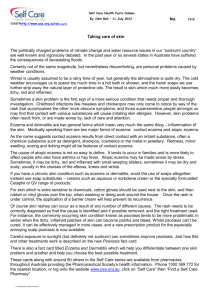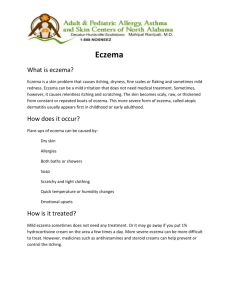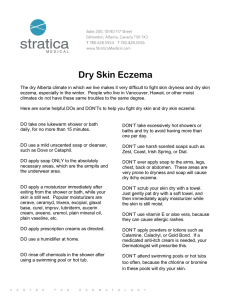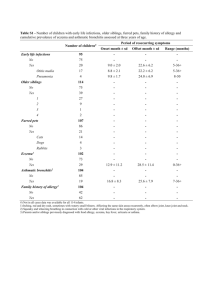Eczema - Canadian Dermatology Association
advertisement
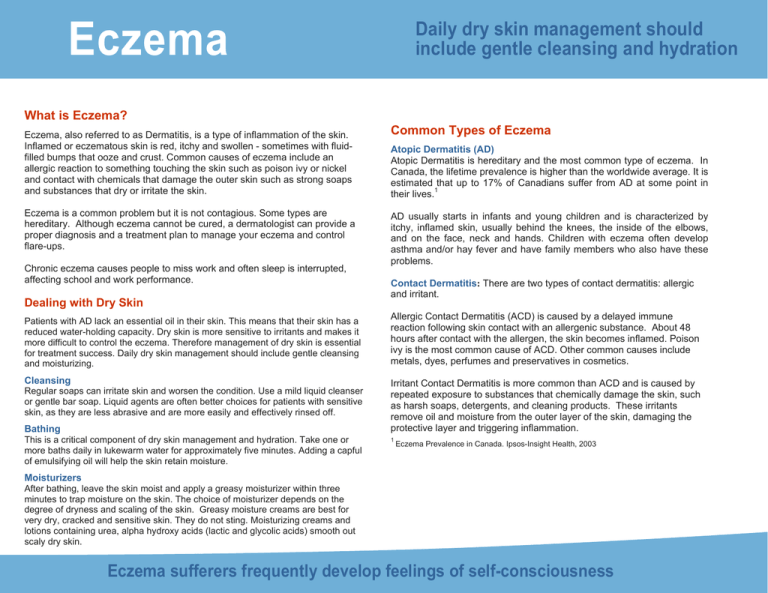
Eczema Daily dry skin management should include gentle cleansing and hydration What is Eczema? Eczema, also referred to as Dermatitis, is a type of inflammation of the skin. Inflamed or eczematous skin is red, itchy and swollen - sometimes with fluidfilled bumps that ooze and crust. Common causes of eczema include an allergic reaction to something touching the skin such as poison ivy or nickel and contact with chemicals that damage the outer skin such as strong soaps and substances that dry or irritate the skin. Eczema is a common problem but it is not contagious. Some types are hereditary. Although eczema cannot be cured, a dermatologist can provide a proper diagnosis and a treatment plan to manage your eczema and control flare-ups. Chronic eczema causes people to miss work and often sleep is interrupted, affecting school and work performance. Dealing with Dry Skin Patients with AD lack an essential oil in their skin. This means that their skin has a reduced water-holding capacity. Dry skin is more sensitive to irritants and makes it more difficult to control the eczema. Therefore management of dry skin is essential for treatment success. Daily dry skin management should include gentle cleansing and moisturizing. Cleansing Regular soaps can irritate skin and worsen the condition. Use a mild liquid cleanser or gentle bar soap. Liquid agents are often better choices for patients with sensitive skin, as they are less abrasive and are more easily and effectively rinsed off. Bathing This is a critical component of dry skin management and hydration. Take one or more baths daily in lukewarm water for approximately five minutes. Adding a capful of emulsifying oil will help the skin retain moisture. Common Types of Eczema Atopic Dermatitis (AD) Atopic Dermatitis is hereditary and the most common type of eczema. In Canada, the lifetime prevalence is higher than the worldwide average. It is estimated that up to 17% of Canadians suffer from AD at some point in their lives.1 AD usually starts in infants and young children and is characterized by itchy, inflamed skin, usually behind the knees, the inside of the elbows, and on the face, neck and hands. Children with eczema often develop asthma and/or hay fever and have family members who also have these problems. Contact Dermatitis: There are two types of contact dermatitis: allergic and irritant. Allergic Contact Dermatitis (ACD) is caused by a delayed immune reaction following skin contact with an allergenic substance. About 48 hours after contact with the allergen, the skin becomes inflamed. Poison ivy is the most common cause of ACD. Other common causes include metals, dyes, perfumes and preservatives in cosmetics. Irritant Contact Dermatitis is more common than ACD and is caused by repeated exposure to substances that chemically damage the skin, such as harsh soaps, detergents, and cleaning products. These irritants remove oil and moisture from the outer layer of the skin, damaging the protective layer and triggering inflammation. 1 Eczema Prevalence in Canada. Ipsos-Insight Health, 2003 Moisturizers After bathing, leave the skin moist and apply a greasy moisturizer within three minutes to trap moisture on the skin. The choice of moisturizer depends on the degree of dryness and scaling of the skin. Greasy moisture creams are best for very dry, cracked and sensitive skin. They do not sting. Moisturizing creams and lotions containing urea, alpha hydroxy acids (lactic and glycolic acids) smooth out scaly dry skin. Eczema sufferers frequently develop feelings of self-consciousness Eczema impacts the quality of life and comfort of sufferers and their families. School, work and sleep are often affected. Other Types of Eczema ECZEMA Treatment Dyshidrotic Eczema: An acute recurrent eruption of multiple tiny, intensely Most types of eczema require a combination of treatments and medications. Your dermatologist will choose the ones that will work the best to control your condition. itchy water blisters on the palms, sides of fingers and soles of the feet. Lichen Simplex Chronicus: Localized, chronic thick itchy plaques that commonly occur on the sides or back of the neck, wrists, ankles, lower legs and inner area of the thighs. Nummular Eczema: Multiple, round plaques of eczema that are usually associated with dry skin and occur on the outer surfaces of the hands, arms and legs. Seborrheic Eczema: Yellowish-brown, greasy, scaly patches on the scalp, eyebrows, nose and chest. Stasis Dermatitis: A chronic eczema on the inner area of the lower legs and associated with varicose veins. Nonprescription Medications Antihistamines relieve itching and help sleep. Moisturizers and emollients decrease dryness and scaling, leaving the skin feeling more comfortable. Barrier repair moisturizers also known as physiologic moisturizers, contain some of the essential oils that are missing from eczematous skin, most commonly ceramide. Coal tar is an old remedy but still effective. It soothes inflamed skin and helps reduce itching, flaking and redness. It is available in bath oils, shampoos, gels, creams, ointments and in combination with corticosteroids. Cool compresses relieve inflammation and itching. Caring for Your Skin Avoid irritants and triggers to reduce flare-ups AD and ACD can worsen with exposure to allergens and irritants. Avoid the common ones, such as dust, animal dander, smoke and grass. Allergy testing can often identify specific environmental allergens. If you have ACD a dermatologist will do patch testing to try to determine the cause. “Dos and Don’ts” Do: • Use mild detergents to wash clothing, with no bleach or fabric softener • Double-rinse clothing • Moisturize often, especially in colder weather • Choose cotton for bed linens and clothing • Reduce stress as much as possible Don’t: • Expose skin to very hot or very cold water • Expose skin to excessive heat or low humidity • Dress in synthetic fabrics or wear wool next to the skin • Use harsh detergents or perfumed products This brochure has been produced with the assistance of an unrestricted educational grant from: Prescription Medications Antibiotics are used to treat secondary skin infection, which is a common complication of any type of eczema. The skin barrier is broken both by scratching and the inflammation allowing bacteria to penetrate the skin. Corticosteroids are the most effective anti-inflammatory agents. They come in a variety of strengths, ranging from mild to extremely potent. They should be applied regularly until the inflammation has resolved. Topical Calcineurin Inhibitors specifically inhibit the cells of the immune system in the skin. They are very effective at reducing itch and preventing flare-ups if applied regularly. Phototherapy: In those who have severe eczema, regular exposure to specific rays of ultraviolet light is very effective in reducing symptoms. This treatment should only be done under the supervision of a dermatologist.
